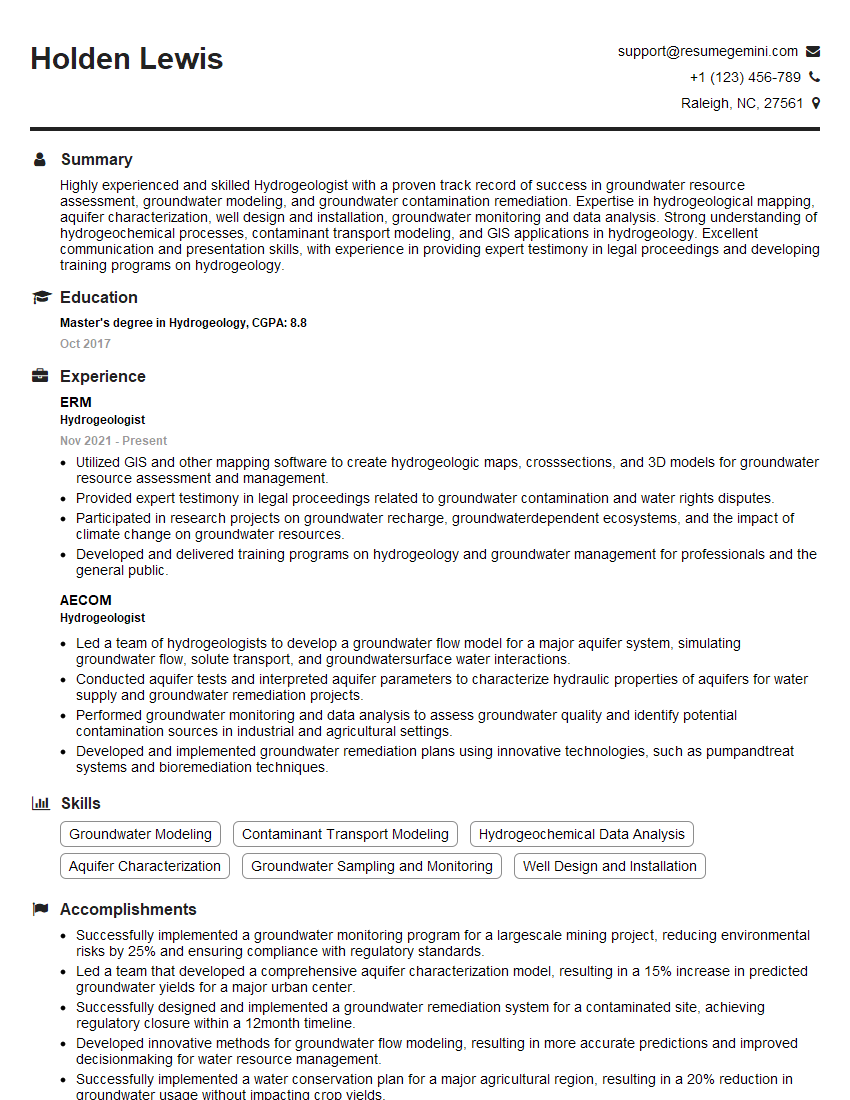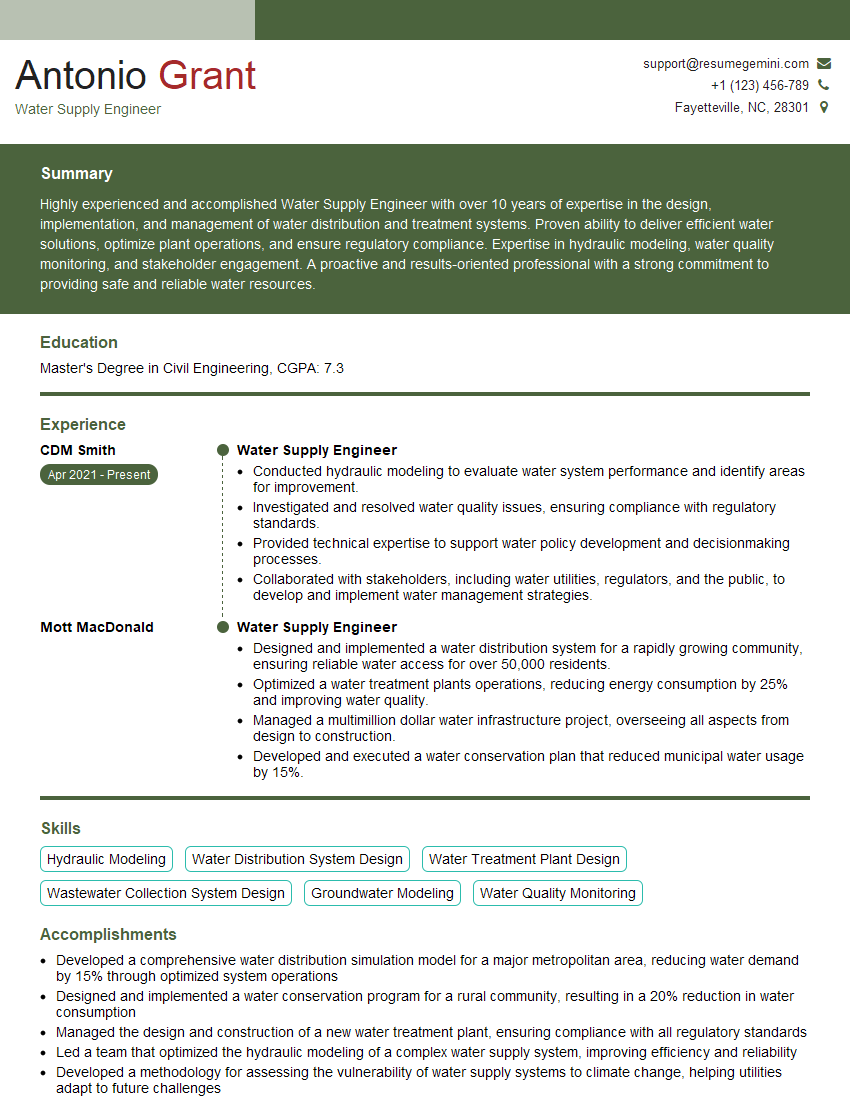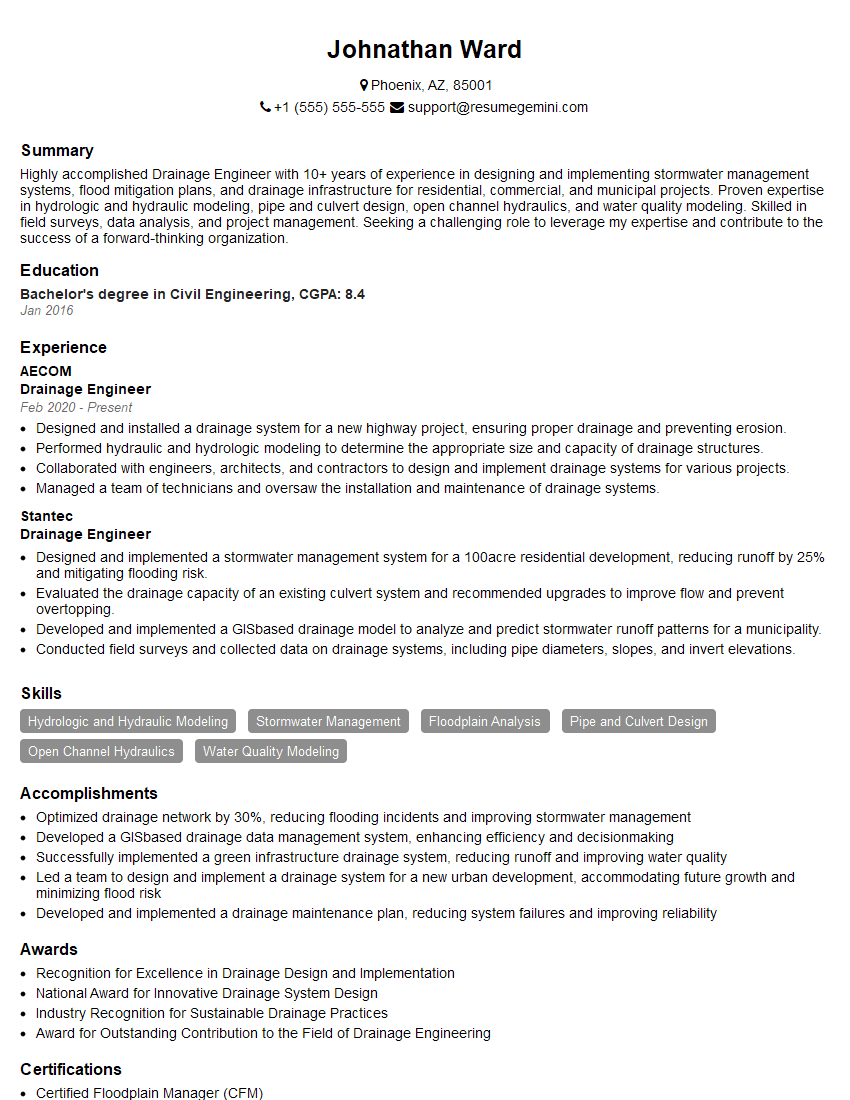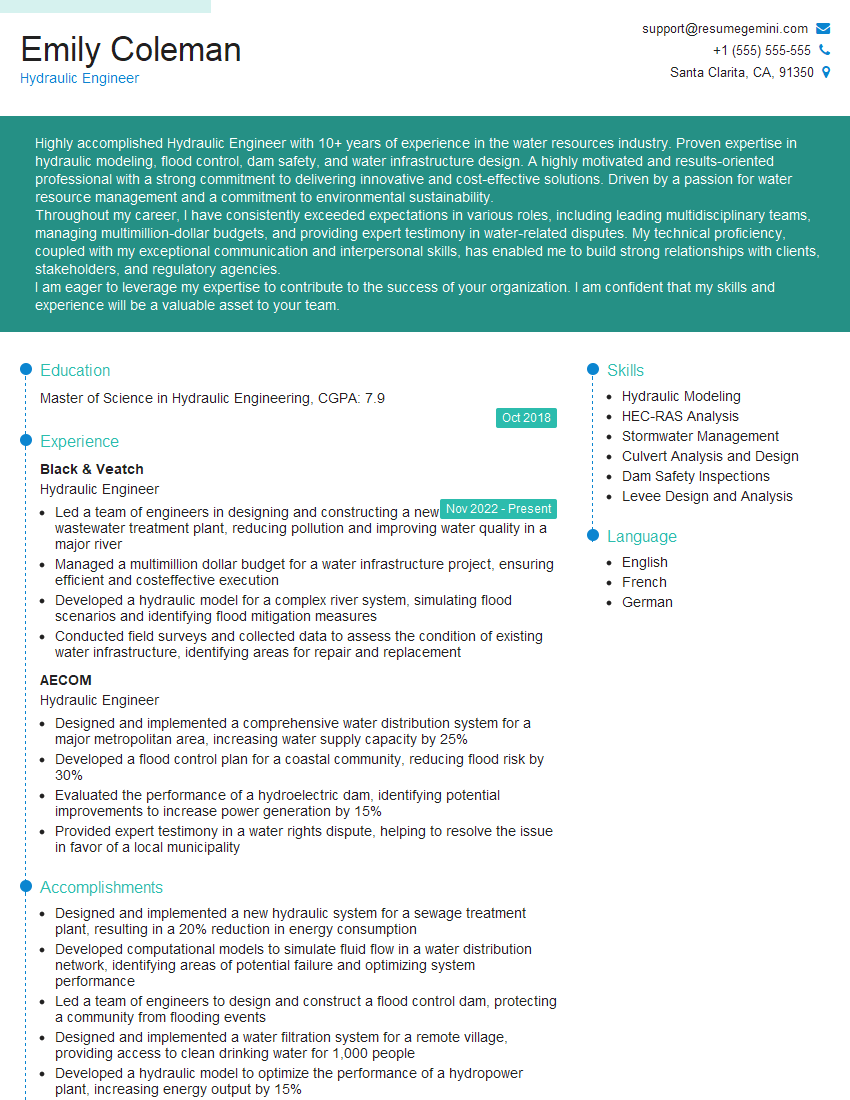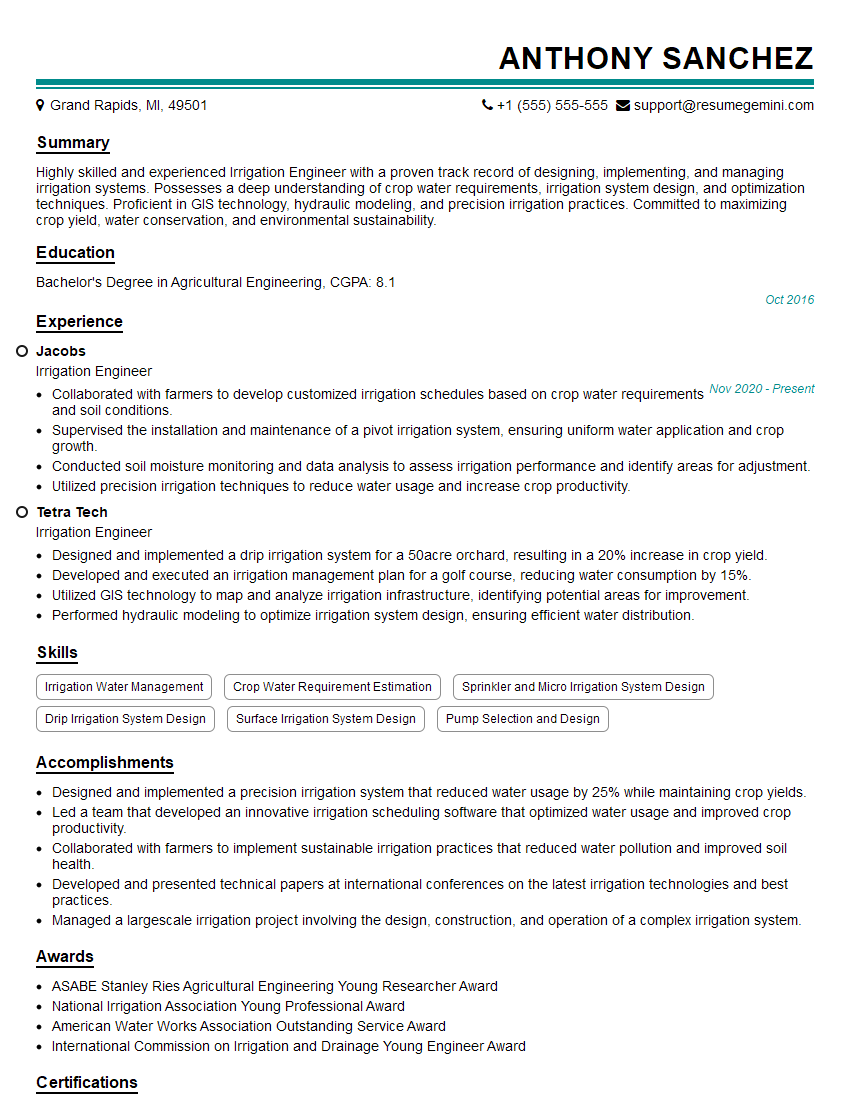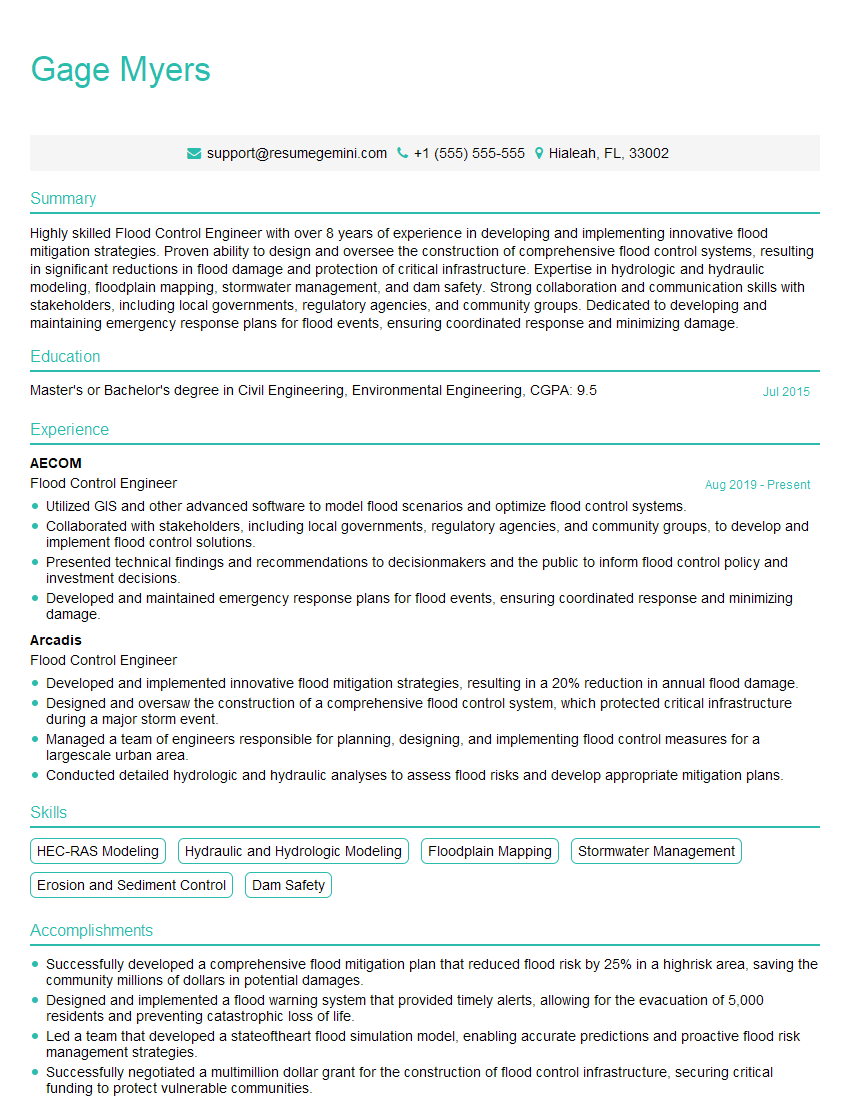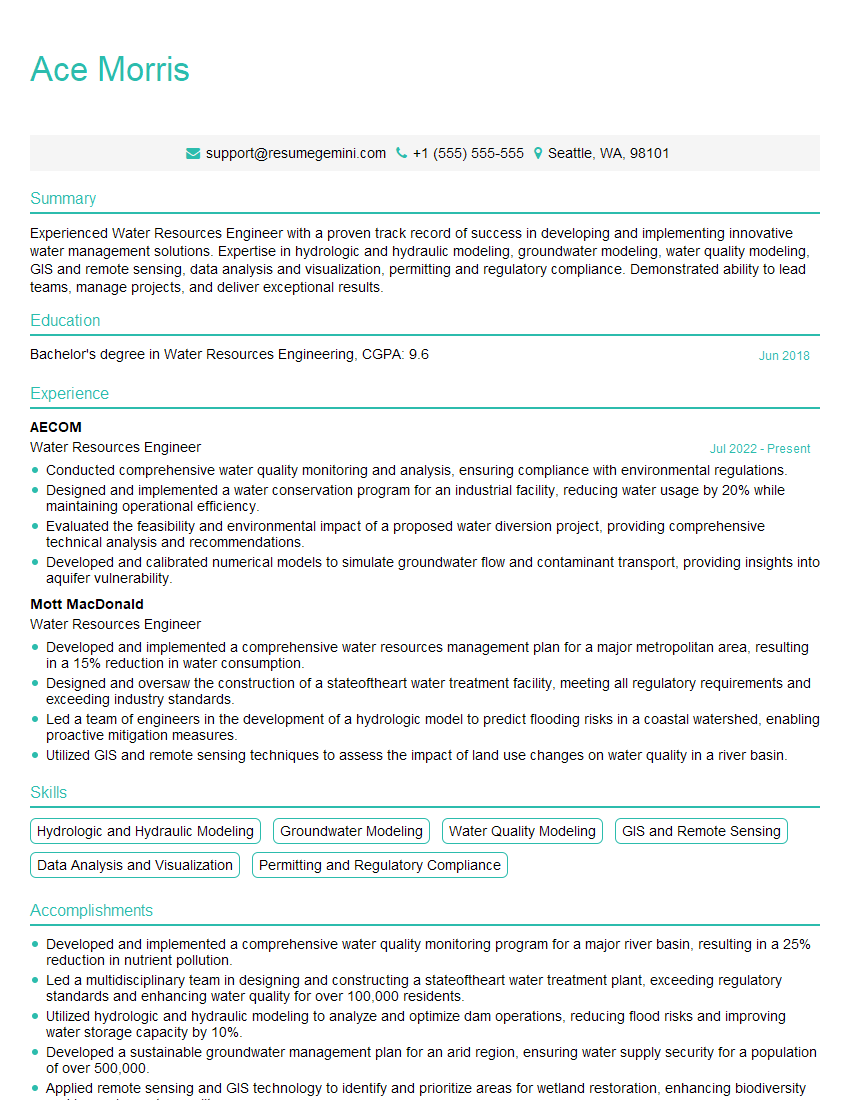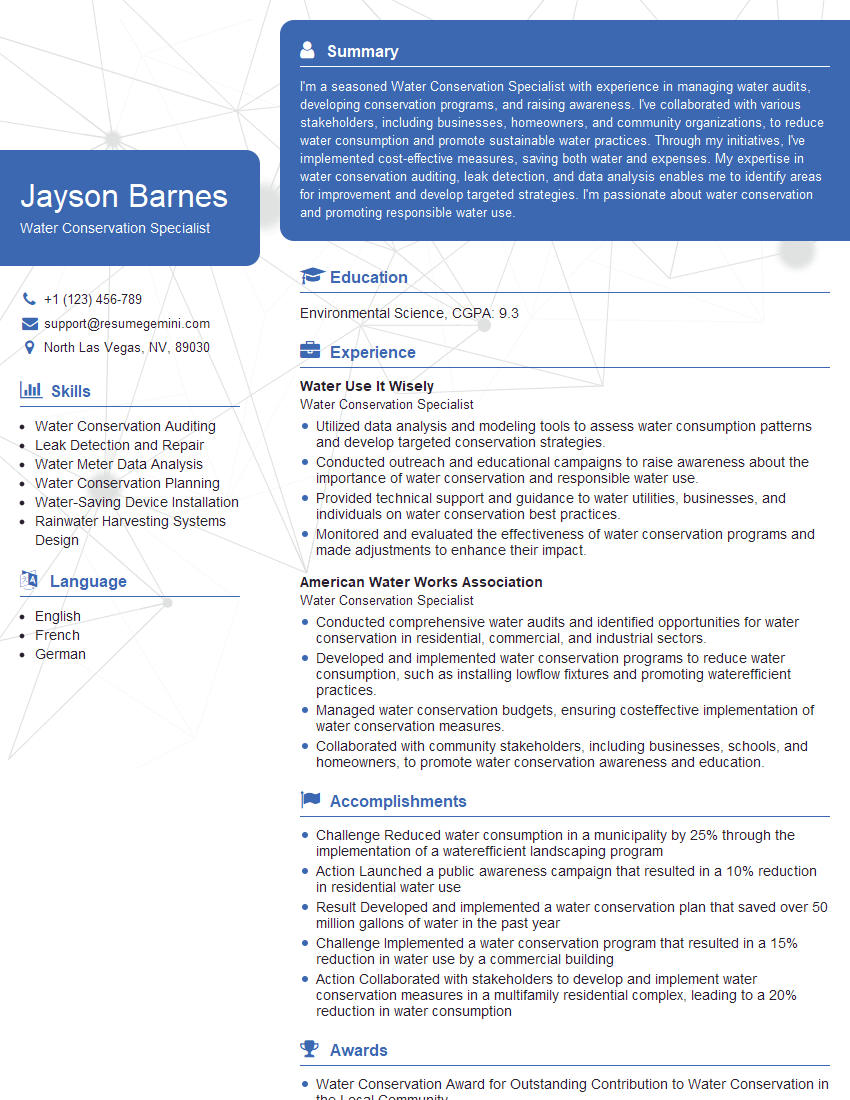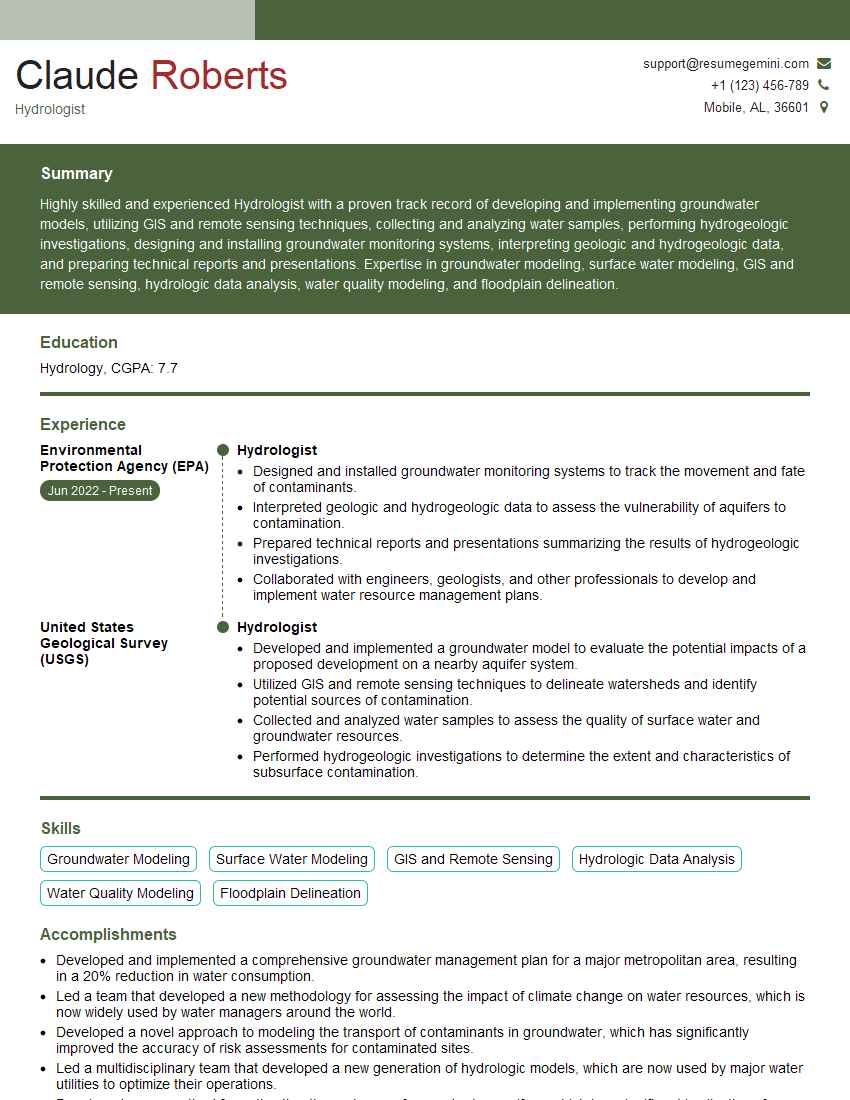Cracking a skill-specific interview, like one for Water Flow Regulation, requires understanding the nuances of the role. In this blog, we present the questions you’re most likely to encounter, along with insights into how to answer them effectively. Let’s ensure you’re ready to make a strong impression.
Questions Asked in Water Flow Regulation Interview
Q 1. Explain the principles of Bernoulli’s equation and its application in water flow regulation.
Bernoulli’s equation is a fundamental principle in fluid mechanics that describes the relationship between pressure, velocity, and elevation in a flowing fluid. Imagine a river flowing downhill – the faster the water moves (higher velocity), the lower its pressure, and the lower its elevation. The equation states that the total energy of the fluid remains constant along a streamline, assuming no energy losses due to friction or other factors.
Mathematically, it’s represented as: P + 1/2ρv² + ρgh = constant, where:
Pis the static pressureρis the fluid densityvis the fluid velocitygis the acceleration due to gravityhis the elevation
In water flow regulation, Bernoulli’s equation helps us understand how changes in pipe diameter or elevation affect pressure and velocity. For example, a constriction in a pipe (like a valve partially closed) will increase velocity and decrease pressure at that point. This principle is used in designing flow meters (Venturi meters) and regulating water pressure in pipelines.
Q 2. Describe different types of water flow (laminar, turbulent) and their implications.
Water flow can be broadly classified into two types: laminar and turbulent. Think of laminar flow as a perfectly orderly parade – all the water molecules move in parallel lines, with smooth, predictable flow. Turbulent flow, on the other hand, is more like a chaotic crowd – water molecules move in irregular, swirling patterns, with unpredictable mixing and energy dissipation.
Laminar flow is characterized by low velocities and high viscosity (thickness) of the fluid. It’s generally more efficient for water conveyance as there’s less energy loss due to friction. Turbulent flow, typically occurring at higher velocities or in rough pipes, leads to significant energy losses due to increased friction and mixing. This can reduce the efficiency of a water system and may require higher pumping pressures to maintain flow.
Understanding flow regime is crucial in designing water systems. For instance, maintaining laminar flow in pipelines minimizes energy consumption and wear on pipe walls.
Q 3. What are the common methods for measuring water flow rate?
Several methods exist for measuring water flow rate, each with its own advantages and limitations. The choice depends on factors such as the pipe size, flow rate range, and desired accuracy.
- Venturi meters: These utilize Bernoulli’s principle – a constriction in the pipe increases velocity and reduces pressure, which is measured to calculate flow rate.
- Orifice plates: Similar to Venturi meters, but simpler and less expensive, they involve a thin plate with a hole in the center that creates a pressure drop.
- Flow nozzles: These offer a smoother flow profile compared to orifice plates, resulting in higher accuracy.
- Magnetic flow meters: These are non-invasive and measure flow rate by detecting the voltage induced by the conductive water moving through a magnetic field.
- Ultrasonic flow meters: These use sound waves to measure the flow velocity, offering a non-invasive option suitable for a variety of pipes and fluids.
- Weirs and flumes: These are open channel flow measurement devices that measure flow rate by observing the water level over or through a controlled structure.
Each method requires specific calibration and consideration of factors like temperature and fluid properties for accurate measurements.
Q 4. How do you calculate the Reynolds number and what does it signify?
The Reynolds number (Re) is a dimensionless quantity that helps us predict whether a flow will be laminar or turbulent. It’s a ratio of inertial forces to viscous forces within a fluid. A low Reynolds number indicates laminar flow, while a high Reynolds number suggests turbulent flow.
The formula for calculating the Reynolds number is: Re = (ρVD)/μ where:
ρis the fluid densityVis the average flow velocityDis the characteristic length (e.g., pipe diameter)μis the dynamic viscosity of the fluid
For example, a Reynolds number of less than 2000 typically indicates laminar flow in a pipe, while a number greater than 4000 usually indicates turbulent flow. The transition zone between 2000 and 4000 is less predictable.
Q 5. Explain the concept of head loss in pipe flow and its calculation.
Head loss refers to the reduction in total energy of a fluid as it flows through a pipe or channel. This energy loss is primarily due to friction between the fluid and the pipe walls, as well as minor losses from fittings, valves, and changes in pipe diameter. Think of it like the energy a ball loses as it rolls across a rough surface.
Head loss is usually calculated using empirical formulas, such as the Darcy-Weisbach equation:
hf = f (L/D) (V²/2g)
hfis the head loss due to frictionfis the Darcy friction factor (dependent on the Reynolds number and pipe roughness)Lis the pipe lengthDis the pipe diameterVis the flow velocitygis the acceleration due to gravity
Minor losses are often added to the frictional head loss to get the total head loss in a system. Understanding head loss is crucial for sizing pumps and ensuring adequate pressure throughout a water distribution network.
Q 6. Describe different types of valves used in water flow regulation and their functions.
Valves are essential components in water flow regulation, allowing us to control the flow rate, pressure, and direction of water. Various types exist, each suited to different applications:
- Gate valves: These open and close by lifting a gate out of the flow path. They are best for fully open or fully closed positions and not for precise flow regulation.
- Globe valves: These regulate flow by restricting it with a disc that moves up and down within a valve body. They offer good flow control but can cause significant head loss at partially closed positions.
- Ball valves: These use a rotating ball with a hole to control flow. They are quick-opening and offer minimal head loss when fully open.
- Butterfly valves: These consist of a disc rotating within the pipe. They’re suitable for larger pipes and offer good flow control, although head loss can be significant at partially closed positions.
- Check valves: These allow flow in one direction only, preventing backflow. They are essential for protecting pumps and preventing water hammer.
The selection of a valve depends on the specific application, required flow control, pressure rating, and head loss considerations.
Q 7. What are the factors affecting water flow in open channels?
Water flow in open channels, like rivers or canals, is influenced by several factors, making it more complex than pipe flow. Think of a river’s flow – it’s affected by the riverbed’s shape, the water’s depth, and even the weather.
- Channel geometry: The shape, size, and roughness of the channel significantly affect flow velocity and discharge. A wider, smoother channel will facilitate faster flow compared to a narrow, rough one.
- Water depth (discharge): The flow rate is directly related to the water depth. A deeper channel can accommodate a higher flow rate.
- Channel slope: A steeper slope leads to a faster flow velocity due to gravity.
- Channel roughness: A rougher channel (e.g., with vegetation or irregularities) increases friction, slowing down the flow.
- Rainfall and inflow: Changes in rainfall and tributary inflows directly affect the flow rate in open channels.
Accurate prediction and management of open channel flow require considering these interacting factors, often using computational models or empirical equations like the Manning’s equation.
Q 8. Explain the Manning’s equation and its application in open channel flow.
Manning’s equation is an empirical formula used to estimate the average velocity of water flowing in an open channel. It’s a fundamental tool in hydraulics, allowing engineers to calculate flow rates and design efficient channels. The equation is:
V = (1/n) * R^(2/3) * S^(1/2)
Where:
Vis the average velocity of flow (m/s or ft/s)nis the Manning’s roughness coefficient (dimensionless), representing the channel’s resistance to flow. This value varies depending on the channel material (e.g., concrete, earth, vegetation). A smoother channel has a lower ‘n’ value.Ris the hydraulic radius (m or ft), which is the cross-sectional area of flow divided by the wetted perimeter.Sis the channel slope (dimensionless), representing the change in elevation over a given distance.
Application: Imagine designing an irrigation canal. Knowing the desired flow rate and the available slope, you can use Manning’s equation to determine the required cross-sectional area and dimensions of the canal. If the calculated velocity is too high, it could cause erosion; if it’s too low, it might lead to sedimentation. Adjusting the channel’s geometry (width, depth) allows you to optimize the flow velocity within an acceptable range.
Example: Let’s say we have a concrete-lined canal with a slope of 0.001 and a Manning’s roughness coefficient of 0.013. Using Manning’s equation and calculating the hydraulic radius for a chosen geometry, we can determine the flow velocity and, consequently, the discharge (flow rate) that the canal can efficiently handle.
Q 9. How do you design a canal or culvert for efficient water flow?
Designing a canal or culvert for efficient water flow requires careful consideration of several factors. The goal is to achieve a balance between minimizing construction costs and ensuring adequate flow capacity without causing erosion or sedimentation. The design process generally involves these steps:
- Hydraulic Analysis: Determine the design flow rate (peak flow) using hydrological data (rainfall records, catchment area). Manning’s equation is critical here to determine the required channel dimensions for the calculated flow.
- Cross-Section Selection: Select an appropriate cross-sectional shape (trapezoidal, rectangular, circular) based on the soil type, construction ease, and flow characteristics. A trapezoidal shape is often preferred for canals due to its stability and efficiency.
- Material Selection: Choose construction materials (concrete, earth, lining) considering factors like cost, durability, and resistance to erosion. The material significantly impacts the Manning’s roughness coefficient.
- Slope Determination: The channel slope plays a crucial role in determining the flow velocity. A steeper slope leads to higher velocity but increases erosion risk. The ideal slope depends on the material and flow characteristics.
- Stability Analysis: Ensure the canal or culvert is stable against erosion and scour (removal of material from the channel bed and banks) by assessing the shear stress exerted by the flowing water. This involves considering factors like soil strength and flow velocity.
- Environmental Considerations: Evaluate the environmental impact of the design, ensuring it doesn’t disrupt natural habitats or water quality.
Example: For a culvert, the design must consider the inflow and outflow conditions to prevent backwater effects or localized scour at the inlet and outlet. This often requires designing the inlet and outlet transitions carefully. For a canal, the alignment should minimize the length of the canal while avoiding steep slopes prone to erosion.
Q 10. What are the different types of pumps used in water distribution systems?
Water distribution systems utilize various pump types depending on the required flow rate, head (pressure), and specific application. Some common types include:
- Centrifugal Pumps: These are the most common type, using rotating impellers to increase fluid velocity and pressure. They are efficient for high flow rates and are available in various sizes and designs.
- Axial Flow Pumps: These pumps move water in a direction parallel to the pump shaft, creating a high flow rate with relatively low head. They are suitable for applications requiring large volumes of water at lower pressures.
- Mixed Flow Pumps: A combination of centrifugal and axial flow pumps, they offer a balance between high flow and head, making them suitable for a wide range of applications.
- Positive Displacement Pumps: Unlike centrifugal pumps, these pumps displace a fixed volume of water with each pump cycle. This makes them suitable for high-pressure applications, such as boosting pressure in a water distribution network.
- Submersible Pumps: Designed to operate underwater, they are often used in well pumping and wastewater applications.
The selection of an appropriate pump depends on a detailed hydraulic analysis of the distribution system, considering factors such as pipe diameters, lengths, elevations, and the required flow and pressure at various points in the system.
Q 11. Explain the concept of water hammer and its mitigation strategies.
Water hammer is a transient pressure surge that occurs in pipelines when the flow is rapidly stopped or started. Imagine turning off a garden hose – you hear a ‘bang’ as the water suddenly stops. In large water pipelines, this ‘bang’ can be a significant pressure surge, potentially damaging pipes and equipment.
Causes: Water hammer is primarily caused by the inertia of the flowing water. When the flow is rapidly changed (e.g., by closing a valve quickly), the water’s momentum causes a pressure wave to travel through the pipeline. The magnitude of the pressure surge depends on several factors including the flow velocity, the speed of wave propagation (dependent on the pipe material and stiffness), and the rate of valve closure.
Mitigation Strategies:
- Slow Valve Closure: Gradually closing valves slows down the change in flow velocity, reducing the magnitude of the pressure surge. This is often achieved through automated valve control systems.
- Surge Tanks: These tanks are installed in the pipeline to absorb the pressure surge. The tank allows the water to flow into or out of it, cushioning the pressure wave.
- Air Chambers: Similar to surge tanks, but smaller, air chambers use compressed air to absorb the pressure fluctuations.
- Pressure Relief Valves: These valves are designed to release excess pressure automatically, preventing damage to the pipeline.
- Pipeline Design: Incorporating flexible pipes or joints can help absorb some of the pressure wave energy.
Q 12. Describe different methods for controlling water levels in reservoirs.
Controlling water levels in reservoirs is crucial for managing water resources efficiently and preventing flooding or water shortages. Several methods are employed:
- Spillways: These structures release excess water from the reservoir, preventing overtopping and potential dam failure. Different types of spillways are used depending on the reservoir size and characteristics.
- Outlet Works: These controlled structures allow for the regulated release of water from the reservoir for irrigation, hydropower generation, or other purposes. They typically include gates that can be operated to manage the flow rate.
- Pumping Systems: Pumps can be used to raise water levels in the reservoir during periods of low inflow or to transfer water to other locations.
- Sediment Control Structures: Managing sediment accumulation is crucial for maintaining reservoir capacity and preventing sedimentation of outlet works. This often involves sediment bypass structures or regular dredging.
- Real-time Monitoring and Control Systems: Modern reservoirs incorporate automated control systems that use real-time data on inflow, rainfall, and reservoir level to automatically adjust the gate openings of the spillways and outlet works.
The specific method or combination of methods used depends on the reservoir’s size, purpose, and environmental considerations.
Q 13. How do you design a spillway for a dam?
Spillway design is a critical aspect of dam safety. It involves determining the spillway type, capacity, and geometry to ensure the safe passage of floodwaters without compromising the dam’s integrity. The design process involves:
- Flood Frequency Analysis: Determining the maximum flood discharge that the spillway must handle based on historical rainfall data and statistical analysis.
- Spillway Type Selection: Choosing the appropriate spillway type (e.g., overflow spillway, side channel spillway, chute spillway) based on factors like the dam’s height, topography, and geological conditions.
- Hydraulic Design: Determining the spillway’s dimensions (width, height, length) to ensure it can safely convey the design flood discharge. This involves using hydraulic models and computer simulations to analyze the flow patterns and water depths.
- Structural Design: Ensuring the spillway’s structural stability and strength to withstand the hydraulic loads and potential erosion. This includes considering the material properties and design loads.
- Erosion Protection: Designing erosion protection measures to prevent scour and erosion around the spillway, particularly at the apron and downstream channel.
- Safety Features: Incorporating safety features such as stilling basins to dissipate energy and reduce erosion.
Spillway design is a complex engineering problem requiring specialist knowledge in hydraulics, hydrology, and structural engineering.
Q 14. What are the considerations for designing a water treatment plant?
Designing a water treatment plant involves a multi-faceted approach ensuring safe and potable water is produced. Key considerations include:
- Source Water Quality: The design must be tailored to the specific characteristics of the source water (e.g., river water, groundwater, lake water), considering its turbidity, organic matter content, and the presence of contaminants.
- Treatment Processes: Selecting appropriate treatment processes to remove impurities. This usually involves a combination of coagulation, flocculation, sedimentation, filtration, and disinfection. Advanced treatment processes may be necessary to remove specific contaminants.
- Plant Capacity: Determining the plant’s capacity (amount of water to be treated per day) based on the projected demand and future growth.
- Water Quality Standards: The plant design must comply with regulatory standards and guidelines for drinking water quality.
- Site Selection: Choosing a suitable site considering accessibility, proximity to the source water, availability of land, and environmental impact.
- Process Control and Instrumentation: Incorporating advanced instrumentation and control systems for monitoring and controlling the treatment processes and ensuring consistent water quality.
- Sludge Management: Developing a plan for managing the sludge (solid waste) generated during the treatment process.
- Energy Efficiency: Designing the plant for energy efficiency to reduce operational costs and minimize the environmental footprint.
Designing a water treatment plant is a complex undertaking, requiring expertise in various disciplines such as chemistry, biology, civil engineering, and environmental engineering.
Q 15. Explain the importance of water quality monitoring in water flow regulation.
Water quality monitoring is paramount in water flow regulation because the quality of the water directly impacts its usability and the health of the ecosystem. Think of it like this: you wouldn’t want to drink from a dirty glass, and similarly, poor water quality can render a water source unusable for drinking, irrigation, or industrial processes. Monitoring helps us understand the presence of pollutants, such as heavy metals, pesticides, or bacteria, which can alter the flow dynamics and cause damage to the environment.
We monitor various parameters, including pH levels, dissolved oxygen, turbidity (cloudiness), nutrient levels (nitrogen and phosphorus), and the presence of specific contaminants. This data helps in identifying pollution sources, predicting potential problems, and implementing effective remediation strategies. For instance, detecting high levels of sediment in a river indicates erosion upstream, requiring action to stabilize the riverbanks. Regular monitoring allows for proactive management, preventing larger-scale environmental damage and ensuring safe and reliable water resources.
Career Expert Tips:
- Ace those interviews! Prepare effectively by reviewing the Top 50 Most Common Interview Questions on ResumeGemini.
- Navigate your job search with confidence! Explore a wide range of Career Tips on ResumeGemini. Learn about common challenges and recommendations to overcome them.
- Craft the perfect resume! Master the Art of Resume Writing with ResumeGemini’s guide. Showcase your unique qualifications and achievements effectively.
- Don’t miss out on holiday savings! Build your dream resume with ResumeGemini’s ATS optimized templates.
Q 16. Describe different methods for managing stormwater runoff.
Managing stormwater runoff effectively is crucial to prevent flooding and water pollution. We utilize a multi-pronged approach, combining various techniques tailored to the specific environment. Imagine a city street after a heavy downpour; if not managed, the water flows directly into drains, potentially overwhelming the system.
- Green Infrastructure: This includes techniques like rain gardens, bioswales (vegetated channels), and permeable pavements, which allow water to infiltrate the ground naturally, reducing runoff volume.
- Grey Infrastructure: This involves traditional engineering solutions such as retention ponds, detention basins (temporary storage areas), and improved drainage systems to control and direct water flow.
- LID (Low Impact Development) Strategies: This holistic approach focuses on minimizing the impact of development on natural water flow patterns. This involves designing landscapes that mimic natural hydrological processes.
- Watershed Management: This involves managing the entire watershed (the area of land where all water drains to a common outlet) to optimize water flow and prevent flooding in downstream areas.
The best approach usually involves a combination of these methods, depending on factors like the size of the area, the amount of rainfall, soil type, and existing infrastructure.
Q 17. How do you assess the risk of flooding in a given area?
Flood risk assessment is a complex process that combines various data sets to identify areas vulnerable to flooding. We use a combination of historical data, hydrological modeling, and geographical information systems (GIS).
- Historical Data Analysis: Examining past flood events, including their extent, frequency, and severity, helps establish a baseline flood risk.
- Hydrological Modeling: Computer models simulate the water flow in a given area under different rainfall scenarios. This helps predict the extent and depth of flooding under various conditions.
- GIS Analysis: Using GIS, we integrate data from topographic maps, land use, soil type, and drainage systems to identify vulnerable areas. We can overlay flood hazard maps with population density maps to assess the potential impact on human life and property.
- Risk Mapping: Combining all this data, we create flood risk maps, illustrating the probability of flooding in different areas. These maps guide mitigation efforts and inform land-use planning decisions.
For example, a low-lying area with poor drainage and a history of flooding would be considered high-risk, while an area with good drainage and minimal historical flooding would be considered low-risk. The level of risk informs the design of mitigation measures, such as flood walls or improved drainage.
Q 18. What are the common methods for erosion control in water systems?
Erosion control in water systems is critical for maintaining water quality, protecting infrastructure, and safeguarding the environment. Think of a riverbank; if it erodes, the sediment can pollute the water, damage structures, and alter the river’s path.
- Vegetative Measures: Planting vegetation, especially native species, on slopes and riverbanks stabilizes the soil and reduces erosion. Roots bind the soil together, preventing it from being washed away.
- Structural Measures: This includes using structures like riprap (rocks), gabions (wire cages filled with rocks), retaining walls, and check dams to slow down water flow and protect vulnerable areas.
- Bioengineering Techniques: This combines both vegetative and structural measures. For example, live staking (planting cuttings of vegetation) can reinforce slopes, providing both structural support and vegetation cover.
- Sediment Control Measures: These measures aim to reduce the amount of sediment entering the water system. This can involve implementing erosion control measures in construction sites or using sediment basins to trap sediment before it reaches the water body.
The selection of appropriate methods depends on the specific site conditions, such as the slope, soil type, and water flow velocity. Often a combination of techniques provides the most effective erosion control.
Q 19. Explain the concept of water balance and its importance in water management.
Water balance refers to the accounting of all water inflows and outflows in a given system, whether it’s a watershed, a reservoir, or even a single field. It’s essentially a water budget. Imagine a bathtub: the water flowing into the tub (inflows) must equal the water flowing out (outflows) plus any change in the water level (storage).
The water balance equation is simple: Inflow – Outflow = Change in Storage
In water management, understanding the water balance is crucial for several reasons:
- Sustainable Water Use: It helps determine the sustainable level of water withdrawal from a system. We can’t extract more water than is naturally replenished.
- Irrigation Management: It helps optimize irrigation schedules, ensuring that enough water is provided for crops without over-irrigating and wasting water.
- Flood Prediction: A well-defined water balance provides data for accurate hydrological models, improving flood prediction and management.
- Reservoir Management: It helps manage reservoir levels, ensuring sufficient water for various needs while mitigating flood risks.
Accurate water balance assessment requires careful monitoring of precipitation, surface runoff, groundwater inflow and outflow, evaporation, and water use.
Q 20. How do you model water flow using computer software?
Modeling water flow using computer software is essential for understanding and managing water resources. We use sophisticated software packages that employ numerical methods to solve complex equations that govern water movement.
Common software includes:
- HEC-RAS (Hydrologic Engineering Center’s River Analysis System): This is widely used for modeling river flow, flood inundation, and dam breach analysis.
- MIKE FLOOD: This software is used for integrated hydrodynamic and hydrological modeling of flood events.
- MODFLOW: This is a widely used groundwater flow model, which simulates the movement of groundwater through aquifers.
These software packages require input data such as topography, rainfall data, river geometry, and boundary conditions. The models then simulate water flow and provide outputs like water depth, velocity, and discharge at various locations and times.
For example, a city planner might use HEC-RAS to model the impact of a new development on the flood risk in a downstream area. The model will simulate the flow changes due to the development and help to design mitigation measures.
Example (Conceptual): Discharge = Area * Velocity This is a basic equation used in many flow models; the software iteratively solves this and many more complex equations to simulate flow accurately.
Q 21. Describe different types of water meters and their applications.
Water meters are devices used to measure the volume or flow rate of water passing through a pipe. Different types of meters cater to various applications and scales.
- Mechanical Meters (Positive Displacement): These meters directly measure the volume of water passing through by using a rotating mechanism. They are reliable for accurate measurement of relatively low flow rates. Example: Nutating disc meter used in residential applications.
- Electromagnetic Meters: These meters use Faraday’s law of induction to measure flow rate. A magnetic field is applied across the pipe, and the voltage induced by the moving water is proportional to the flow rate. They are suitable for large pipes and high flow rates.
- Ultrasonic Meters: These meters use sound waves to measure flow rate. By measuring the time it takes for sound waves to travel with and against the flow, the flow velocity can be calculated. They are non-invasive, requiring no contact with the water.
- Venturi Meters: These meters use a constriction in the pipe to create a pressure difference. The pressure difference is related to the flow rate and requires less maintenance compared to others.
- Smart Meters: These are advanced meters with integrated electronics that allow remote monitoring and data transmission. They often combine aspects from other meter types and provide valuable data for water management.
The choice of meter depends on factors like flow rate, pipe size, accuracy requirements, cost, and the need for remote monitoring capabilities. Residential applications commonly use mechanical meters, while large-scale water distribution systems often use electromagnetic or ultrasonic meters.
Q 22. What are the challenges associated with managing water resources in arid regions?
Managing water resources in arid regions presents unique and significant challenges. The primary issue is the scarcity of water itself. This scarcity necessitates careful planning and efficient use of every drop. Other key challenges include:
- High evaporation rates: The intense sun and heat lead to significant water loss through evaporation from reservoirs and during transportation.
- Water quality issues: Limited water sources can be prone to salinity and contamination, requiring expensive treatment processes.
- Increased competition for resources: Agriculture, industry, and domestic uses all compete for limited water, leading to conflicts and the need for equitable allocation strategies.
- Infrastructure limitations: Building and maintaining water infrastructure (dams, pipelines, treatment plants) in harsh desert environments is expensive and challenging.
- Climate change impacts: Arid regions are particularly vulnerable to climate change, with potential for increased droughts and erratic rainfall patterns, exacerbating water stress.
For example, the Aral Sea, once one of the world’s largest lakes, has shrunk dramatically due to unsustainable irrigation practices in the surrounding arid region, highlighting the devastating consequences of poor water management.
Q 23. Explain the concept of sustainable water management.
Sustainable water management is about balancing the needs of today’s population with the needs of future generations. It’s not just about having enough water, but also about ensuring its quality and availability for all uses. This approach requires a holistic perspective, considering:
- Water conservation: Implementing strategies to reduce water consumption through efficient irrigation techniques, leak detection, and public awareness campaigns.
- Water reuse and recycling: Treating wastewater for reuse in agriculture or industry, minimizing fresh water demand.
- Integrated water resources management (IWRM): A collaborative approach involving all stakeholders (farmers, industries, government agencies, etc.) to make informed decisions about water allocation and management.
- Protection of water ecosystems: Maintaining the health of rivers, lakes, and wetlands to ensure their ecological integrity and their role in the water cycle.
- Adaptation to climate change: Implementing measures to prepare for the impacts of climate change, such as increased droughts and floods.
A great example is Singapore, a country with limited water resources, which has invested heavily in desalination, water recycling (‘NEWater’), and rainwater harvesting to ensure water security.
Q 24. How do you design a water distribution network?
Designing a water distribution network is a complex process involving several steps. It begins with a thorough understanding of the water demand, both current and projected future needs. The design then incorporates various factors:
- Demand assessment: Estimating water consumption patterns for domestic, commercial, and industrial uses.
- Source selection: Identifying reliable water sources (reservoirs, groundwater, etc.) and assessing their quality and capacity.
- Pipeline layout: Designing a network of pipes to efficiently deliver water to all consumers. This includes consideration of pipe diameter, material, and pressure.
- Pumping stations: Determining the location and capacity of pumping stations to maintain adequate pressure throughout the network.
- Storage facilities: Incorporating reservoirs or tanks to store water and regulate supply during peak demand periods.
- Network analysis: Using hydraulic modeling software to simulate water flow and pressure under different scenarios. This ensures the system is designed for optimal performance and reliability.
The design must also factor in considerations like topography, soil conditions, and environmental regulations. For example, a mountainous region requires different pipeline design compared to a flat plain. Software such as EPANET is commonly used for hydraulic modeling.
Q 25. What are the environmental regulations related to water flow regulation?
Environmental regulations related to water flow regulation are crucial for protecting aquatic ecosystems and ensuring sustainable water use. These regulations vary by location but generally address:
- Water quality standards: Setting limits on pollutants and contaminants to protect water quality for drinking, recreation, and aquatic life.
- Minimum stream flows: Requiring a minimum amount of water to be maintained in rivers and streams to support aquatic habitats and downstream users.
- Wetland protection: Regulating activities that could impact wetlands, which play a vital role in water filtration and flood control.
- Water withdrawals: Limiting the amount of water that can be withdrawn from rivers and groundwater sources to prevent depletion.
- Dam safety: Establishing safety standards for dam construction and operation to prevent catastrophic failures.
For example, the Clean Water Act in the United States sets national standards for water quality and regulates discharges of pollutants into waterways. Similar legislation exists in many other countries.
Q 26. Explain the concept of water rights and their implications.
Water rights define the legal entitlements to use water from a specific source. These rights can be based on various principles, including:
- Prior appropriation: The first person to use water for a beneficial purpose has the right to continue using it, even if it impacts others (common in the western United States).
- Riparian rights: Landowners adjacent to a water body have the right to use water from that body, but their use must be reasonable and not interfere with the rights of other riparian owners.
- Public trust doctrine: The government holds water resources in trust for the benefit of the public, and has a responsibility to manage them sustainably.
The implications of water rights are significant, affecting water allocation decisions, agricultural practices, and economic development. Conflicts over water rights are common, especially in areas with limited water resources. Water rights are often complex, involving legal interpretations and negotiations among stakeholders.
Q 27. Describe different strategies for water conservation.
Water conservation strategies focus on reducing water consumption while maintaining essential needs. These can be categorized into:
- Technological solutions: Implementing water-efficient irrigation systems (drip irrigation, micro-sprinklers), low-flow toilets and showerheads, and leak detection systems.
- Behavioral changes: Promoting public awareness campaigns to educate people about water conservation practices, such as shorter showers, responsible gardening, and fixing leaks promptly.
- Policy measures: Implementing water pricing policies that reflect the true cost of water, providing incentives for water conservation, and regulating water use in specific sectors (agriculture, industry).
- Improved infrastructure: Investing in modern infrastructure to reduce water losses from leakage in the distribution network.
- Water reuse and recycling: Treating wastewater for reuse in irrigation or industrial processes.
For example, California’s drought-response policies included strict regulations on outdoor water use and incentives for water-efficient landscaping. These measures helped to reduce water consumption during the drought period.
Q 28. How do you use GIS technology for water resources management?
Geographic Information Systems (GIS) technology is a powerful tool for managing water resources. GIS allows for the visualization, analysis, and management of spatial data related to water. Its applications include:
- Mapping water resources: Creating maps of rivers, lakes, groundwater aquifers, and other water bodies.
- Monitoring water quality: Integrating data from water quality monitoring stations to track changes in water quality over time and space.
- Modeling water flow: Simulating water flow in rivers and aquifers to predict the impacts of various management actions.
- Managing water infrastructure: Tracking the location and condition of water infrastructure, such as dams, pipelines, and treatment plants.
- Planning water development projects: Assessing the environmental and social impacts of proposed water projects, such as dams and reservoirs.
GIS software enables water managers to create interactive maps that integrate multiple datasets, allowing for better informed decision-making. For example, GIS can be used to identify areas vulnerable to flooding or drought, helping to prioritize water management interventions.
Key Topics to Learn for Water Flow Regulation Interview
- Hydraulic Principles: Understanding fundamental concepts like Bernoulli’s principle, pressure head, velocity head, and energy losses in pipes.
- Pipe Network Analysis: Applying methods like Hardy Cross or linear programming to analyze complex pipe networks, determining flow distribution and pressure gradients.
- Valve Selection and Operation: Knowledge of various valve types (gate, globe, butterfly, etc.), their applications, and the impact of their operation on flow control and pressure management.
- Flow Measurement Techniques: Familiarity with different flow meters (Venturi, orifice, ultrasonic, etc.), their principles of operation, accuracy, and limitations.
- Water Hammer Analysis: Understanding the causes and consequences of water hammer, and methods to mitigate its effects (e.g., surge tanks, air chambers).
- Pump Systems and Operation: Knowledge of centrifugal and positive displacement pumps, pump curves, system curves, and optimization of pump operation for efficient water flow regulation.
- Control Systems and Automation: Understanding SCADA systems, programmable logic controllers (PLCs), and their role in automated water flow regulation and monitoring.
- Leak Detection and Management: Methods for identifying and repairing leaks in water distribution systems to minimize water loss and maintain efficient flow.
- Water Quality Considerations: Understanding how flow regulation can impact water quality and the importance of maintaining appropriate water pressure and flow rates.
- Sustainability and Water Conservation: Exploring strategies for efficient water use and management, including the role of smart water grids and advanced metering infrastructure.
Next Steps
Mastering Water Flow Regulation opens doors to exciting career opportunities in the water industry, offering a chance to contribute to vital infrastructure projects and sustainable water management. To maximize your job prospects, creating a strong, ATS-friendly resume is essential. ResumeGemini can significantly enhance your resume-building experience by providing you with the tools and resources you need to create a professional and effective document that highlights your skills and experience. Examples of resumes tailored to Water Flow Regulation are available to help you get started.
Explore more articles
Users Rating of Our Blogs
Share Your Experience
We value your feedback! Please rate our content and share your thoughts (optional).
What Readers Say About Our Blog
Hello,
We found issues with your domain’s email setup that may be sending your messages to spam or blocking them completely. InboxShield Mini shows you how to fix it in minutes — no tech skills required.
Scan your domain now for details: https://inboxshield-mini.com/
— Adam @ InboxShield Mini
Reply STOP to unsubscribe
Hi, are you owner of interviewgemini.com? What if I told you I could help you find extra time in your schedule, reconnect with leads you didn’t even realize you missed, and bring in more “I want to work with you” conversations, without increasing your ad spend or hiring a full-time employee?
All with a flexible, budget-friendly service that could easily pay for itself. Sounds good?
Would it be nice to jump on a quick 10-minute call so I can show you exactly how we make this work?
Best,
Hapei
Marketing Director
Hey, I know you’re the owner of interviewgemini.com. I’ll be quick.
Fundraising for your business is tough and time-consuming. We make it easier by guaranteeing two private investor meetings each month, for six months. No demos, no pitch events – just direct introductions to active investors matched to your startup.
If youR17;re raising, this could help you build real momentum. Want me to send more info?
Hi, I represent an SEO company that specialises in getting you AI citations and higher rankings on Google. I’d like to offer you a 100% free SEO audit for your website. Would you be interested?
Hi, I represent an SEO company that specialises in getting you AI citations and higher rankings on Google. I’d like to offer you a 100% free SEO audit for your website. Would you be interested?
good
